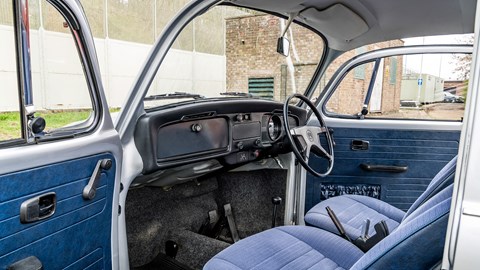► How to buy a classic
► We drive VW’s heritage car
► But tell you what to look for
More than 21 million Beetles were produced between 1938 and 2003, the majority of them at VW HQ in Wolfsburg, Germany, or in Mexico or Brazil. All models and eras have a following, but expert Bill Rudman singles out the 1967 model as a great usable buy. ‘It’s got the classic look combined with more modern 12v electrics and running gear, including the 1500cc engine [although smaller engines were still available],’ he says. ‘That all carried over into 1968, but the look changed.’
Prices are relatively affordable given the Beetle’s iconic status. You’ll pay around £15k for a good example of that transitional 1967 model, and typically £10k for those produced from 1968 onwards, including cars built in Brazil and Mexico.
What should you go for?
‘People were sniffy about Brazilian and Mexican Beetles years ago, but they’re worth the same now.’
Pre-1958 models are most prized. Powered by 1131cc or 1192cc flat fours with 25bhp or 30bhp, these cars are easily identified by an oval rear window (split before 1953), tiny ‘snowflake’ rear lights and thinner ‘blade’ bumpers. Budget £20k for a car in good condition, stretching to £30k tops, advises Rudman.
Volkswagen Beetle: the specs
- On sale 1938-2003
- Price then £660 (1968)
- Value now £10k
- Engine 1192cc 8v boxer 4-cyl, 34bhp, 61lb ft
- Transmission 4-speed manual, rear-wheel drive
- Performance 35sec 0-62mph, 79mph, 34mpg
We’re driving Volkswagen UK’s own heritage car, a fully restored 1.2 and one of the last German-made cars. Chunkier bumpers, ‘football’ rear lights and the shorter bonnet and rear deck-lid are tell-tales it’s on the modern side of that 1967 changeover.
What’s it actually like to drive?
You’re struck by the comfort of the angled-back velour seats, the caverns beneath the thin little dash that provide so much legroom, and that central speedometer – the only dial – which takes no less than 35 seconds to move from zero to 60mph. Yes, 35 seconds.

But this is a surprisingly taut driving experience: the thin steering rim weights up with precision, the gearlever slices cleanly across the gate, the brakes are effective, and after a little roll the Beetle settles, giving you confidence to push on through a corner. Pushing on is all relative, of course, but that air-cooled engine is so full of charisma and enthusiasm that you forget touching 55mph cross-country is an achievement.
Affordable, fun and easy to maintain, the Beetle would be a great classic even without its contribution to world history, popular culture and the development of the automobile. But that wider significance means there’s even more reason to buy.
Other things to look out for
- Engines typically require a rebuild at 60k miles. Budget £2k to get the job done properly.
- Began as a 1.1, but the largest engine was 1500cc with 44bhp. This is viewed as the most desirable – balanced and blueprinted, and fitted with a few simple mods, it can make 70-80bhp.
- Fuel pans, front axles and the heater channels can rot; check the bottom four inches of the car.
- Starting issues are common, including starter motor gremlins and ignition switch failure, but are easily fixed.
- 1967 models are prized for classic looks combined with more modern running gear including 1500cc engine and 12v electrics.
- From 1968 to the end of production, the Beetle received larger ‘Europa’ bumpers and rear lights.